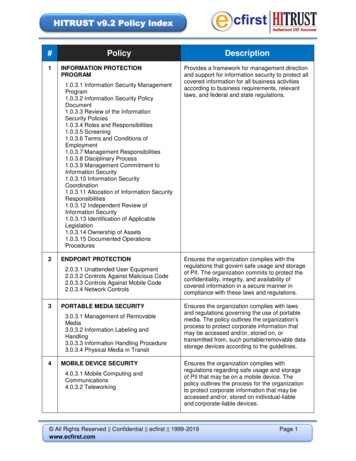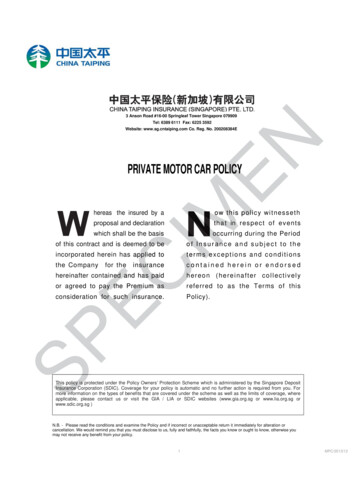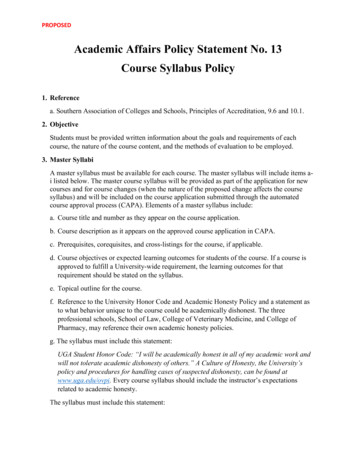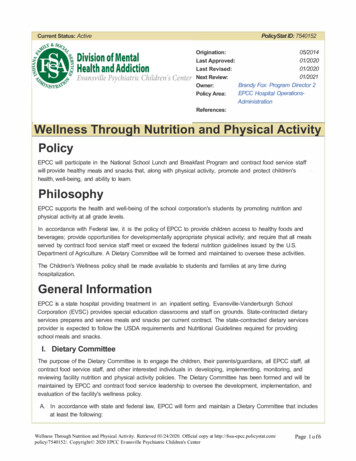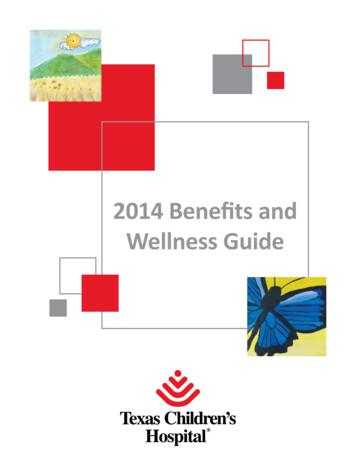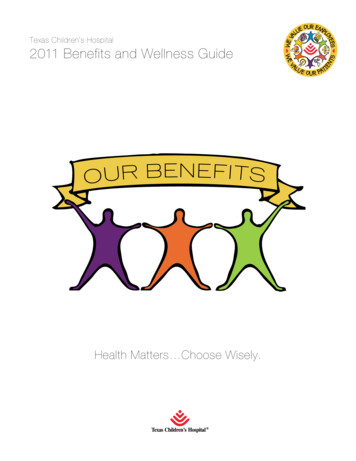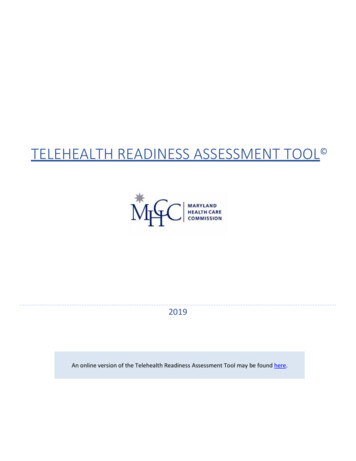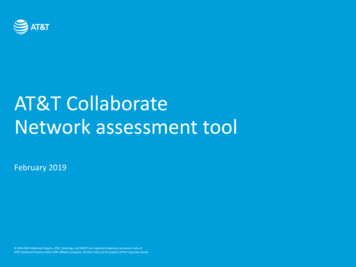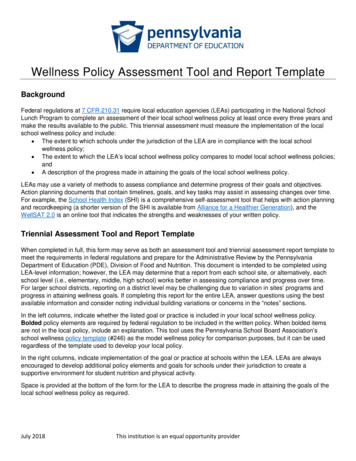
Transcription
Wellness Policy Assessment Tool and Report TemplateBackgroundFederal regulations at 7 CFR 210.31 require local education agencies (LEAs) participating in the National SchoolLunch Program to complete an assessment of their local school wellness policy at least once every three years andmake the results available to the public. This triennial assessment must measure the implementation of the localschool wellness policy and include: The extent to which schools under the jurisdiction of the LEA are in compliance with the local schoolwellness policy; The extent to which the LEA’s local school wellness policy compares to model local school wellness policies;and A description of the progress made in attaining the goals of the local school wellness policy.LEAs may use a variety of methods to assess compliance and determine progress of their goals and objectives.Action planning documents that contain timelines, goals, and key tasks may assist in assessing changes over time.For example, the School Health Index (SHI) is a comprehensive self-assessment tool that helps with action planningand recordkeeping (a shorter version of the SHI is available from Alliance for a Healthier Generation), and theWellSAT 2.0 is an online tool that indicates the strengths and weaknesses of your written policy.Triennial Assessment Tool and Report TemplateWhen completed in full, this form may serve as both an assessment tool and triennial assessment report template tomeet the requirements in federal regulations and prepare for the Administrative Review by the PennsylvaniaDepartment of Education (PDE), Division of Food and Nutrition. This document is intended to be completed usingLEA-level information; however, the LEA may determine that a report from each school site, or alternatively, eachschool level (i.e., elementary, middle, high school) works better in assessing compliance and progress over time.For larger school districts, reporting on a district level may be challenging due to variation in sites’ programs andprogress in attaining wellness goals. If completing this report for the entire LEA, answer questions using the bestavailable information and consider noting individual building variations or concerns in the “notes” sections.In the left columns, indicate whether the listed goal or practice is included in your local school wellness policy.Bolded policy elements are required by federal regulation to be included in the written policy. When bolded itemsare not in the local policy, include an explanation. This tool uses the Pennsylvania School Board Association’sschool wellness policy template (#246) as the model wellness policy for comparison purposes, but it can be usedregardless of the template used to develop your local policy.In the right columns, indicate implementation of the goal or practice at schools within the LEA. LEAs are alwaysencouraged to develop additional policy elements and goals for schools under their jurisdiction to create asupportive environment for student nutrition and physical activity.Space is provided at the bottom of the form for the LEA to describe the progress made in attaining the goals of thelocal school wellness policy as required.July 2018This institution is an equal opportunity provider
Wellness Policy Assessment Tool and Report TemplateLEA / District Name: Girard School DistrictReporting Timeframe (month/year to month/year): 4/2017-4/2020Name(s) of Reviewer(s): GSD Wellness CommitteeSchool Name (if applicable):Select grades:PK K 1 2 3 4 5 6 7 9 8 10 11 12 Included in thewritten policy?Implemented in theschool building(s)?YesFully inPlaceNoPartiallyin PlaceNot inPlacePublic Involvement, Notification, and AssessmentWe have LEA official(s)/designee(s) in charge of wellness policycompliance.Name(s)/Title(s): Donna Miller, SuperintendentWe complete an assessment of the local school wellness policy at leastevery three years (“triennial assessment”).Triennial assessment results are made available to the public in an easilyaccessible manner.Website address and/or description of how to access ?uREC ID 372758&type dAt least every three years we use the results of the triennial assessment toupdate or modify the wellness policy as needed.The LEA informs and updates the public about the contents, updates, andimplementation of the wellness policy at least annually and the policy isaccessible to the public.Website address for policy and/or description of how to access copy:Notice is sent out in fall district newsletter as well as posted on school website: https://www.girardsd.org/apps/pages/iWe retain records as required by federal regulations including: The written school wellness policy, Documentation of making the wellness policy publicly available, Documentation of outreach efforts inviting stakeholders to participate in thewellness committee / wellness policy process, and Copy of triennial assessment and documentation of reporting results to public.The LEA utilizes a wellness committee that includes these communitystakeholders in the development, implementation, review, and update of thewellness policy: Administrators Food service staff School health professionals Parents School board members PE teachers Students Public Other stakeholders (describe):Notes on public involvement, notification, and assessment:The Girard School District shall improve awareness of Policy #246 School Wellness by including information on the policy and directionsfor electronic access in the newsletter.Nutrition Education*Nutrition education is provided within PDE’s sequential, comprehensive healtheducation standards.We teach, model, encourage, and support healthy eating through nutritioneducation.July 2018This institution is an equal opportunity provider1
Wellness Policy Assessment Tool and Report TemplateIncluded in thewritten policy?Implemented in theschool building(s)?YesFully inPlaceNoPartiallyin PlaceNot inPlaceWe provide all students with knowledge and skills for healthy lives via nutritioneducation.We offer age-appropriate nutrition education and activities to students in: Elementary School Middle School High SchoolOur nutrition education curriculum teaches behavior-focused skills such as menuplanning, reading nutrition labels, and media awareness.School food service and nutrition education classes work together to create alearning laboratory.In addition to meeting academic standards for nutrition education, we integratenutrition education into a variety of subjects (e.g., math, science, language arts).We reinforce lifelong lifestyle balance by linking nutrition and physical activity.Staff providing nutrition education receive standards-based training andprofessional development.We engage and involve families and the community in nutrition education efforts.Other goal (describe): Notes on goals for nutrition education:GSD seeks to increase outreach to families and community members to solidify wellness education given in school through promotion ofnutrition/wellness programs, community events, partnerships, and extra-curricula opportunities.Nutrition Promotion*We use evidence-based techniques and nutrition messages in school andencourage participation in school meal programs.We participate in Farm to School activities such as having a school garden, tastetesting local products, incorporating local foods into school meals, and educatingstudents in the classroom and on field trips about local agriculture.We cooperate with community agencies and organizations to provideopportunities for student projects related to nutrition.We implement behavioral economics techniques in the cafeteria to encourageconsumption of whole grains, fruits, and vegetables and to decrease plate waste.We display and disseminate consistent nutrition messages in schools,classrooms, cafeterias, homes, community, and media.Our staff model healthy eating in front of students and avoid using unhealthyfoods in classroom lesson plans.We offer health and nutrition resources to parents to help them provide healthymeals for their children.Other goal (describe):Notes on goals for nutrition promotion:GSD seeks to increase Farm to School activities by exploring the feasibility of a community garden in collaboration with the Elk CreekRecreation Board.Physical Activity*We provide a variety of developmentally appropriate opportunities for physicalactivity during the school day for all students.We contribute to the effort to provide students daily opportunities to accumulate atleast sixty minutes of age-appropriate physical activity daily as recommended bythe CDC.July 2018This institution is an equal opportunity provider2
Wellness Policy Assessment Tool and Report TemplateIncluded in thewritten policy?Implemented in theschool building(s)?YesFully inPlaceNoPartiallyin PlaceNot inPlaceIn addition to planned physical education, we offer activities such as indoor andoutdoor recess, before and after school programs, intramurals, interscholasticathletics, and clubs to meet the needs and interests of our students.We maintain a physical and social environment that encourages safe andenjoyable activity for all students.We discourage extended periods of inactivity (two hours or more) for students.We provide physical activity breaks in the classroom.We offer before and/or after-school programs that include physical activity forparticipating children.We partner with parents/guardians and community members and organizations(e.g., YMCA, Boys & Girls Clubs, local parks, hospitals, etc.) to offer programssupporting lifelong physical activity.We do not use physical activity as a punishment (e.g., running laps).We do not withhold physical activity as a punishment (e.g., taking away recess).We encourage walking and biking to school.We encourage students and families to use our physical activity facilities, such asplaygrounds and ball fields, outside of school hours in accordance with schoolrules.Other goal (describe):Notes on goals for physical activity:GSD will continue our partnership with the Elk Valley Recreation Board and other community partners to offer wellness activities forstudents, families and community members throughout the year.Physical Education (PE)We implement a PE program consistent with state academic standards.All students participate in PE.PE instruction promotes skills and knowledge necessary for lifelong physicalactivity.PE classes provide the means for students to learn, practice, and be assessed ondevelopmentally appropriate skills.Our curriculum promotes both team and individual activities.We offer a comprehensive PE course of study with planned instruction time forstudents to meet standards at the proficient level.We use a local assessment system to track student progress on state standards.Students are moderately to vigorously active as much time as possible during PEclass. Accommodations are made in class for documented medical conditions anddisabilities.We provide safe and adequate equipment, facilities, and resources for PE class.Certified health and PE teachers teach our classes.We provide professional development for PE staff.PE classes have a teacher-student ratio similar to other courses for safe andeffective instruction.We do not use or withhold physical activity as a form of punishment in PE class.Other goal (describe):Our PE courses emphasize a fitness for life philosophy. Teachers will encourage students to utilize the skills learned in class outside ofthe school day.Notes on goals for physical education:July 2018This institution is an equal opportunity provider3
Wellness Policy Assessment Tool and Report TemplateIncluded in thewritten policy?Implemented in theschool building(s)?YesFully inPlaceNoPartiallyin PlaceNot inPlaceOther School-Based Wellness Activities*Free drinking water is available and accessible to students during meal periodsand throughout the school day.School nutrition staff meet local hiring criteria and in compliance with federalregulations.We provide continuing education to school nutrition staff as required by federalregulations.We provide adequate space for eating and serving school meals.We provide a safe and clean meal environment for students.We offer students enough time to eat (10 minutes sit down time for breakfast; 20minutes sit down time for lunch) and schedule meal periods at appropriate hours.We implement alternate school breakfast service models to increase participation,such as “grab & go,” breakfast served in the classroom, and breakfast after firstperiod.Students have access to hand washing or sanitizing before meals.Only authorized staff have access to the food service operation.We provide the nutrition content of school meals to the school community.We include students/parents in menu selections through taste-testing andsurveys.We utilize outside funding and programs to enhance school wellness.We train all staff on the components of the school wellness policy.School based activities are planned with wellness policy goals in mind.Fundraising projects submitted for approval are supportive of healthy eating andstudent wellness.We encourage administrators, teachers, school nutrition professionals, students,parents/guardians, and community members to serve as positive role modelsthrough district programs, communications, and outreach.We communicate information to parents/guardians to support their efforts toprovide a healthy diet and daily physical activity for their children.Indoor air quality is in accordance with our healthy learning environment programand applicable laws and regulations.Other goal (describe):Notes on goals for other school-based activities:GSD seeks to increase communication to families and community members via the website regarding health and wellness programs,opportunities, and home application, e.g. lesson extensions, recipes, etc.Nutrition Guidelines for All Foods and Beverages at SchoolWe consider promoting student health and reducing obesity when offering foodsand beverages to students at school.Foods and beverages provided through the National School Lunch andSchool Breakfast Programs comply with federal meal standards.We offer healthy food and beverage options at school-sponsored events, such asdances and sporting events.Foods and beverages outside of the school meal, which are sold to studentsat school during the school day, meet or exceed the established federalcompetitive food standards (USDA Smart Snacks in School). Venuesinclude vending, school stores, non-exempt fundraisers, and a la carteitems.July 2018This institution is an equal opportunity provider4
Wellness Policy Assessment Tool and Report TemplateIncluded in thewritten policy?Implemented in theschool building(s)?YesFully inPlaceNoPartiallyin PlaceNot inPlaceWe limit the number of food fundraisers at school and have procedures in placefor requesting a fundraiser exemption (i.e., selling foods that do not meet SmartSnacks) in accordance with limits set by PDE.We have local standards in our written policy for foods and beveragesoffered for free to students at school, including food rewards, items offeredat classroom parties and celebrations, and foods/beverages provided to theclass as shared classroom snacks.We provide a list of nonfood ideas and healthy food/beverage alternatives to staffand parents/guardians.Only foods and beverages that meet or exceed federal nutrition standards(USDA Smart Snacks in School) are permitted to be marketed or promotedto students during the school day. Examples: posters, vending machines,menu boards, cups for beverage dispensing, coolers, trash cans.Notes on nutrition guidelines for foods and beverages at school:The Girard School District will continue to provide nutrition education to those support groups, such as PTOs, and booster organizations,who are active in fundraising.* At least one goal for these categories must be included in the written policy per federal regulations.Report on the progress made in attaining the goals of the wellness policy (REQUIRED):GSD continues to achieve full compliance with all state and federal wellness regulations, as well as surpassing many ofthem. Student wellness opportunities during the school day have increased. Subcontracting our food services in 2018-2019greatly expanded nutrition access, promotion, and education for all students. Elk Valley Elementary School attained CEPstatus 2018-19 and Rice Avenue Middle School attained CEP status in 2019-2020, meaning all students enrolled in thoseschools now receive free breakfast and lunch. Middle School lunches are available through a grab and go model to increaseschool breakfast participation. Required Consumer Science in the middle grade levels emphasize nutrition and cultivatinghealthy life habits. Through a major project in 2018-19, the Girard School District website was redesigned and now hasimproved capacity to be used as an information tool for the community. All three buildings now utilize an email blast tofamilies further expanding the opportunity to disseminate health and wellness information to GSD families.July 2018This institution is an equal opportunity provider5
May 05, 2020 · (SHI) is a comprehensive self-assessment tool that helps with action planning and recordkeeping (a shorter version of the SHI is available from Alliance for a Healthier Generation ), and the WellSAT 2.0 is an online tool that indicates the strengths and weaknesses of your written policy. Triennial Assessment

